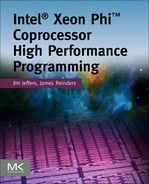Table of Contents
Why Intel® Xeon Phi™ coprocessors are needed
The first Intel® Xeon Phi™ coprocessor
Keeping the “Ninja Gap” under control
Transforming-and-tuning double advantage
When to use an Intel® Xeon Phi™ coprocessor
Maximizing performance on processors first
Why scaling past one hundred threads is so important
Maximizing parallel program performance
Measuring readiness for highly parallel execution
Beyond the ease of porting to increased performance
Transformation for performance
Hyper-threading versus multithreading
Coprocessor major usage model: MPI versus offload
Compiler and programming models
Chapter 2. High Performance Closed Track Test Drive!
Looking under the hood: coprocessor specifications
Starting the car: communicating with the coprocessor
Taking it out easy: running our first code
Starting to accelerate: running more than one thread
Petal to the metal: hitting full speed using all cores
Easing in to the first curve: accessing memory bandwidth
High speed banked curved: maximizing memory bandwidth
Chapter 3. A Friendly Country Road Race
Preparing for our country road trip: chapter focus
Getting a feel for the road: the 9-point stencil algorithm
At the starting line: the baseline 9-point stencil implementation
Rough road ahead: running the baseline stencil code
Cobblestone street ride: vectors but not yet scaling
Open road all-out race: vectors plus scaling
Some grease and wrenches!: a bit of tuning
Chapter 4. Driving Around Town: Optimizing A Real-World Code Example
Choosing the direction: the basic diffusion calculation
Turn ahead: accounting for boundary effects
Finding a wide boulevard: scaling the code
Thunder road: ensuring vectorization
Peeling out: peeling code from the inner loop
Trying higher octane fuel: improving speed using data locality and tiling
High speed driver certificate: summary of our high speed tour
Chapter 5. Lots of Data (Vectors)
Five approaches to achieving vectorization
Six step vectorization methodology
Streaming through caches: data layout, alignment, prefetching, and so on
Use array sections to encourage vectorization
Look at what the compiler created: assembly code inspection
Numerical result variations with vectorization
Chapter 6. Lots of Tasks (not Threads)
OpenMP, Fortran 2008, Intel® TBB, Intel® Cilk™ Plus, Intel® MKL
Choosing offload vs. native execution
Language extensions for offload
Using pragma/directive offload
Using offload with shared virtual memory
About asynchronous computation
About asynchronous data transfer
Applying the target attribute to multiple declarations
Performing file I/O on the coprocessor
Logging stdout and stderr from offloaded code
Chapter 8. Coprocessor Architecture
The Intel® Xeon Phi™ coprocessor family
Intel® Xeon Phi™ coprocessor silicon overview
Individual coprocessor core architecture
Instruction and multithread processing
Cache organization and memory access considerations
Vector processing unit architecture
Coprocessor PCIe system interface and DMA
Coprocessor power management capabilities
Reliability, availability, and serviceability (RAS)
Coprocessor system management controller (SMC)
Chapter 9. Coprocessor System Software
Coprocessor software architecture overview
Coprocessor programming models and options
Coprocessor software architecture components
Intel® manycore platform software stack
Linux support for Intel® Xeon Phi™ coprocessors
Tuning memory allocation performance
Chapter 10. Linux on the Coprocessor
Introduction to coprocessor Linux bootstrap and configuration
Default coprocessor Linux configuration
Changing coprocessor configuration
Coprocessor Linux boot process
Coprocessors in a Linux cluster
Intel Math Kernel Library overview
Using the coprocessor in native mode
Using compiler-assisted offload
Precision choices and variations
Using MPI on Intel® Xeon PhiTM coprocessors
Prerequisites (batteries not included)
Using MPI natively on the coprocessor
Chapter 13. Profiling and Timing
Event monitoring registers on the coprocessor
Intel® VTune™ Amplifier XE product
Performance application programming interface
